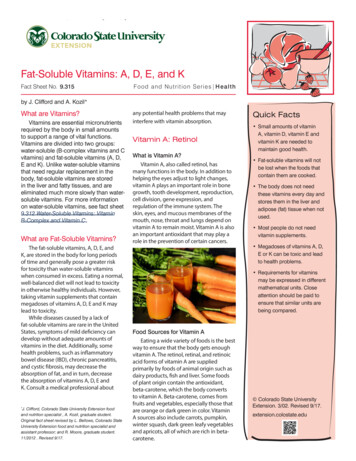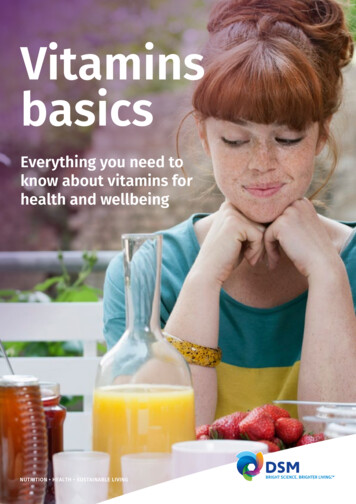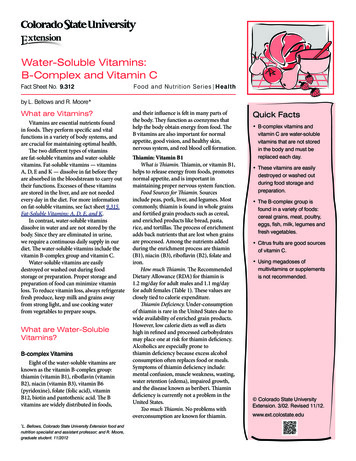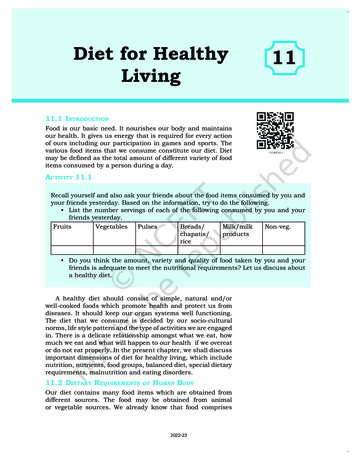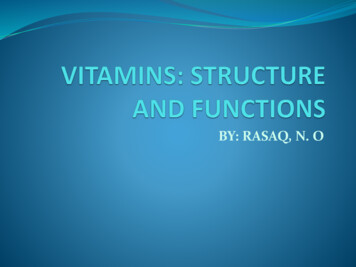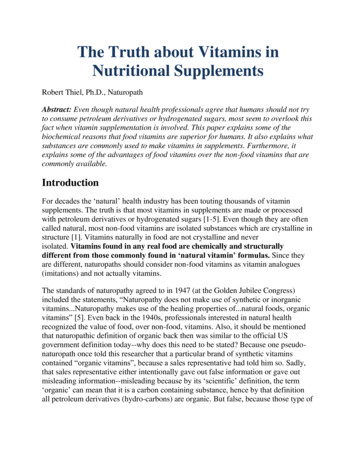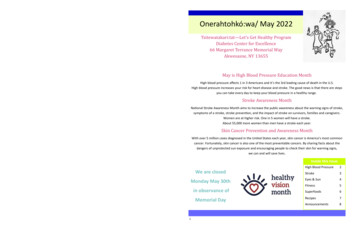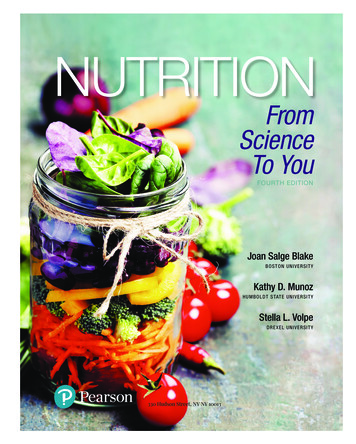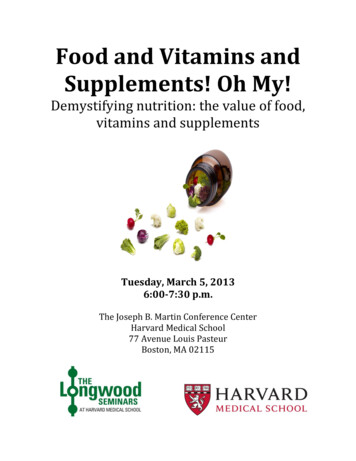
Transcription
ITIMll INERALHELP OR Hi\RM?@wCharlesW. Marshall, Ph.D.Sf JXtEDITED BY SfEPHEN BARRETT. M.D
VITAMINSANDMINERALS:HELP OR HARM?Charles W. Marshall, Ph.D.A People's Health Library BookEdited byStephen Barrett, M.D.[JI210 W. Washington SquareGeorge F. Stickley CompanyPhiladelphia, PA 19106
The People's Health Library is a series of easy-to-read books written by expertswho explain health and health care concepts for the general public. For a complete list of titles, send a self-addressed, stamped envelope to the George F.Stickley Company, 210 West Washington Square, Philadelphia, PA 19106.First published 1983, hardcover edition, by the George F. StickleyCompany. Copyright 1985, 1986, paperback edition, revised and updated by the George E Stickley Company.ISBN-89313-072-9All Rights Reserved. No part of this book may be reproduced in any formwithout permission from the publisher.Printed and Manufactured in the United States and published by the GeorgeF. Stickley Company, 210 West Washington Square, Phila., Pa. 19106.iv
ContentsForeword By Dr. William J. DarbyIntroductionixxiFAITH VS. REASON1.2.3.4.5.6.How Supplements are PromotedDanger in the BottleScience vs. QuackeryCommon Beliefs-How Tme?What Is A Vitamin?Non-Vitamins and Phony Vitamins1612202732FAT-SOLUBLE VITAMINS7.8.9.10.Vitamin AVitamin DVitamin EVitamin KCan Help or HarmCan Help or HarmCan Help or HarmCan Help or Hann40526480WATER-SOLUBLE VITAMINS11. B·Vitamins Can Help or Bann12. Vitamin C Can Help or Harm85107MEGAVITAMIN CLAIMS DEBATED13. Can Megavitamin C Help Colds or Other Infections?14. Can Megavitamin E Help the Heart, Prolong Life,Increase Sexuality or Do Anything EJse for You?15. Can Megavitamins Help Mental Health?16. Can Megavitamins Help Against Cancer?17. Can Megavitamins Help Reduce Cholesterol andProtect Against Heart Disease?122133144152165MINERALS CAN HELP OR HARM18. The Macrominerals: Calcium, Phpsphorus, Magnesium,Sodium, Potassium and Chloride19. Zinc, Selenium and Copper20. Iron, Iodine, Fluorine and Other Microminerals171181195SENSIBLE NUTRITION21.22.23.24.Who is at Risk for Deficiency?Wise Food SelectionHeart Disease, Cancer and DietShould You Take Supplements?205220227236Appendix A. Glossary239Appendix B. Recommended Dietary Allowances (RDAs)U.S. Recommended Daily Allowances (U.S. RDAs)248249Appendix C. Recommended Reading250Index252v
This book is dedicated to:Charles Glen King, Ph.D.Emeritus Professor of ChemistryColumbia College of Physicians and SurgeonsandThomas H. Jukes, Ph.D.Professor of Medical Physicsand Lecturer in NutritionUniversity of California (Berkeley)Dr. King, co-discoverer of vitamin C, helped to organize ColumbiaUniversity's Institute of Human Nutrition and was a founding Scientific Director and later President of the Nutrition Foundation.Dr. Jukes, another pioneer vitamin researcher, contributed to theunderstanding of several B-vitamins, particularly pantothenic acid, andhas crusaded relentlessly against dangerous vitamin misinformation andother forms of nutrition quackery.vi
AcknowledgmentsIn researching and writing this book, I leaned heavily on the generousassistance of many, many persons. Despite the risk of omitting someonewho helped, I wish to express my gratitude to the following:Dr. Thomas F. Gallagher, Professor of Biochemistry, who long agotaught me the scientific method.Dr. Victor Herbert, whose indignation against health quackery inspiredme in January of 1975 to start the research for this book.Dr. Stephen Barrett, my trusty editor, whose expert guidance helpedtransform an overly long manuscript into a readable, reliable book.Mrs. Jeanne Hartenstein, Chief Librarian, Health Sciences Library,Bronson Methodist Hospital, Kalamazoo, Michigan, who scoured librariesnationwide to obtain copies of references difficult to find.Mrs. Louise Lasworth, Librarian in the Science Library of G. D. Searle& Co., Skokie, Illinois.The Upjohn Company of Kalamazoo for granting me guest privileges inits medical-science library; and also its librarians, Mrs. Lyga Greenfieldand Mrs. Herberta Carver.Mrs. Frances McAfee, who helped type the original manuscript underdifficult circumstances.Mrs. Shirlee Cummins, who typed the entire second draft manuscriptunder rush request.Mrs. Kathleen Onofrio, Chief Librarian, South Haven (Michigan) Memorial Library, who read much of the original manuscript and offeredcomments based on her estimate of the general public's interest in vitamins.A very special appreciation goes to the following scientists who readone or more selected chapters of the first and/ or the final draft of mymanuscript and offered constructive criticism and encouragement.Roslyn Alfin-Slater, Ph.D., Professor and Chairman, Department ofEnvironmental and Nutritional Sciences, School of Public Health, University of California, Los Angeles.Terence Anderson, M.D., Head, Department of Health Care and Epidemiology, University of British Columbia.Jay Arena, M.D., Past-President of the American Academy of Pediatricsand Professor of Pediatrics, Duke Medical Center.Ernest Beutler, M.D., Chairman, Basic and Clinical Research, ScrippsClinical Research Foundation, La Jolla, California.John Bieri, Ph.D., National Institutes of Health (now retired).vii
viiiAcknowledgmentsGeorge Briggs, Ph.D., Professor and Past-Chairman of the Departmentof Nutritional Sciences, University of California, Berkeley.Charles Butterworth, M.D., Professor of Medicine and Nutrition, Uni·versity of Alabama.William J. Darby, M.D., Ph.D., Emeritus Professor of Medicine, Vanderbilt University School of Medicine.Hector DeLuca, Ph.D., Professor and Chairman of the Department ofBiochemistry, University of Wisconsin.Alfred Harper, Ph.D., Professor of Biochemistry, University ofWisconsin.Victor Herbert, M.D., J.D., Chief of Hematology and Nutrition, V.A.Medical Center, Bronx, New York.Thomas Jukes, Ph.D., Professor of Medical Physics and Lecturer inNutrition, University of California, Berkeley.David Kritchevsky, Ph.D., Associate Director, Wistar Institute of Anatomy and Biology, Philadelphia.Morris A. Lipton, M.D., Professor of Psychiatry and Director, Biological Sciences Research Center of the Child Development Research Institute,University of North Carolina, Chapel Hill.George V. Mann, M.D., Professor of Medicine, Vanderbilt University.Jacob Nevyas, Ph.D., Sc.D., Emeritus Professor of Chemistry, Philadelphia College of Optometry.Irwin Rosenberg, M.D., Professor of Medicine, Director of the ClinicalNutrition Research Center, University of Chicago.Howerde E. Sauberlich, Ph.D., Professor and Director, Division of Experimental Nutrition, Department of Nutritional Sciences, University ofAlabama.William Sebren, Ph.D., retired Director of the Institute of Human Nutrition, Columbia College of Physicians & Surgeons.Noel W. Solomons, M.D., Professor of Nutrition and Food Science,Massachusetts Institute of Technology.Fredrick J. Stare, M.D., Ph.D., Emeritus Professor of Nutrition, Harvard University School of Public Health.Philip White, Sc.D., Director, American Medical Association Divisionof Personal and Public Health Policy.Hilda S. White,Ph.D., Nutrition Consultant, Wilmette, Illinois.Myron Winick, M.D., Professor of Pediatrics and Nutrition and Director, Institute of Human Nutrition, Columbia College of Physicians &Surgeons.George Wolf, Ph.D., Professor, Department of Nutrition & Food Science, Massachusetts Institute of Technology.Vernon Young, Ph.D., Professor of Nutritional Biochemistry, Massachusetts Institute of Technology.
ForewordMillions of Americans now dose themselves frequently with vitaminsand minerals they don't need. Some do this out of fear that they won'tget enough from their food; while others hope that extra large quantitiesof nutrients can prevent or cure a wide range of diseases. Althoughthousands of books encourage self-medication with nutrients, only a fewwarn of the dangers involved. Yet the scientific evidence is clear: all substances, even vitamins, are toxic in sufficient excess-and legitimate medical uses of large amounts (megadoses) are quite rare.How did vitamins become so popular? Dr. Marshall explains that although the word "vitamin"-like "vital" and "vitality"-suggests greatimportance to health, there is no simple way for individuals to measurehow much they need. These facts, combined with a large army of Pi dPipers and the persuasive power of the mass media, have produced a 3billion/year industry. During many years as a nutrition educator, I havepainfully observed the growth of this problem.Vitamins and Minerals: Help or Harm? is a much-needed book, usefulto laypersons and health professionals alike. It answers basic questionslike: What are vitamins and minerals? What do they do for you? Howmuch of them do you need? Who is at risk for deficiency? Which foodscontain which nutrients? How can you tell if you are getting enough? Howmuch is too much? What happens if you ingest more than you need? Whencan vitamins and minerals be used legitimately in the prevention and treatment of disease? In this book you will find documented facts that completely counter the myths of Pied Pipers.While there is little scientific controversy about vitamins, there is genuine controversy about the role of diet in producing heart diseases and cancer. This book examines these issues and provides practical advice forhealthy eating.Adelle Davis, a major promoter of nutrition misinformation, dominatedthe talk-show circuit until her death in 1974. Her books sold millions ofcopies and still are popular. Did you know that much of her advice wasirresponsible? Or that her book Lefs Have Healthy Children was quietlyrecalled from the market after the death of a child whose mother followedthe book's advice? You will find the details in Dr. Marshall's book. LinusPauling's zealous advocacy has also played a big role in the current vitamin boom. This book examines his speculations and the evidence againstthem-perhaps more thoroughly than any other book published.ix
xForewordThe authors of the recent book, Life Extension, claim that hundreds ofresearch studies support their unorthodox ideas that extensive nutrientsupplementation may prolong life. Vitamins and Minerals: Help or Harm?contains facts that refute these claims.Dr. Marshall deserves our thanks for consolidating and interpreting anenormous amount of information published in scientific journals and elsewhere-a process that has obviously taken countless hours of effort. Hedeserves further appreciation for the care he has taken to seek expertreview of his work to assure its soundness.This is a book you can trust!William J. Darby, M.D., Ph.D.Dr. Darby is Professor Emeritus of Biochemistry (Nutrition) at Vanderbilt University School of Medicine and is a member of the AmericanSociety of Clinical Nutrition and the National Academy of Sciences. Hewas President of the Nutrition Foundation from 1971 to 1982 and hasbeen President of the American Institute of Nutrition. He has served onthe editorial boards of three scientific journals: Nutrition Reviews, theJournal of Nutrition, and the Journal of Clinical Investigation. He haswritten approximately 200 scientific articles and two books: Food: TheGift of Osiris and Nutrition and Diet in Health and Disease.
IntroductionEven nectar is a poison if taken in excess.-Old Hindu ProverbThe purpose of this book is to discourage you from taking extra vitamins and minerals-especially large doses-if you don't need them. It isbased on years of intensive study of the scientific literature and correspondence with many of the nation's top nutrition experts. I wrote it because I became angry about the dangerously misleading advice the publichas been getting from popular "nutrition" and vitamin books and fromtalk show interviews with phony "experts."The discovery of vitamins is one of mankind's greatest achievements.Yet it has also led to widespread hucksterism. There is no shortage ofso-called "experts" to tell you to supplement your diet, to diagnose yourevery symptom as a "deficiency disease," and to treat yourself with onenutrient or another. But what about risks? Although the dangers of unnecessary vitamins have been reported in scientific journals, they areseldom brought to public attention. This I determined to do soon after Iretired from 25 years of active research in the field of biochemistry.This book tells how nutrients can harm as well as help, how selfappointed "experts" can lead you astray, and how to tell the differencebetween a real expert and a phony. It may also shock you with real storiesbased on medical reports of vitamin and mineral poisoning of adults andchildren.Charles W. Marshall, Ph.D.xi
1How SupplementsAre Promoted"A great deal of intelligence can be investedin ignorance when the need for illusion is deep."-Saul Bellow1A visitor from outer space might get the impression that Americans arenow in great danger of vitamin and mineral deficiency. One hundred yearsago, such a visitor would have seen pioneer settlers of America's West ableto toil 14 hours a day on a daily intake of only 15-30 mg of vitamin C, 2and able to beget many children on a daily intake of not more than 15 IUof vitamin E.Today, to the horror of nutrition scientists, enormous quantities of vitamins and minerals are being sold in doses up to 30 times this high in pharmacies, supermarkets, department stores and "health food" stores. Theyare being sold by mail. They are also being sold person-to-person by hugenumbers of individuals who have become "distributors" for giant companies like Shaklee and Amway. Total sales are close to 3 billion a year.Millions of Americans are now on the vitamin bandwagon of daily, andoften too potent, vitamin and mineral supplements. They are being luredto the "vitality with vitamins" parade by a strange band of Pied Pipersuntrained, pseudoscientific, self-styled "nutritionists," supported by asmall, well-educated but often irrational group of Ph.D. and M.D. scientists. (Just because someone has earned a doctoral degree in the biologicalor medical sciences doesn't mean that he or she is immune to faulty scientific judgment!)The main sales pitch of these vitamin salesmen is "Make sure you getenough!" They don't usually tell you how much is enough. And they rarelytell you how much is too much.1
2An Innocent Victim3Take the case of Ted B. In 1971, when he was 16 years old, Ted begantaking vitamin A because he had heard it could help the acne on his face.By the end of a few weeks, he was taking 200,000 units daily. (Nutritionists recommend 5,000 units a day in our diet.) He kept this up for twoyears. As his 18th birthday approached, he became weak, and thenweaker. His appetite went way down, he lost 10 pounds, his gums beganto bleed easily and so did his nose. His skin began to itch and flake overmost of his body, his hair began to fall out, and he developed daily headaches, nausea and vomiting.Soon Ted had involuntary leg twitchings, and finally the unbearable happened: his eyeballs began to move uncontrollably. Frightened, he draggedhimself to the local hospital where the doctors measured the amount ofvitamin A circulating in his blood. It was close to 100 times the normalamount! The diagnosis of chronic vitamin A poisoning was quickly made,and Ted quite willingly stopped taking his supplements.On the 9th day of his hospital stay, Ted's abdomen swelled up withenough fluid that the doctors had to drain some of it out through a largeneedle inserted into the abdominal cavity. Fortunately, this problem didnot recur. By the 30th hospital day, Ted felt recovered and was sent home.His system had not completely restored the level of minerals lost from hisbones, but this too would eventually return to normal.Who Is Responsible?Where did young Ted get the idea to take all that vitamin A? The medical report doesn't tell us, but it is not hard to imagine the answer. Manypopular books about "nutrition" recommend vitamin A for acne and awhole host of other problems. The books vary in recommended dosage,but they have one thing in common. Almost none of them warns thereader that too much vitamin A can be harmful. Moreover, there is a general philosophy among vitamin promoters that if a little bit is good, moreis likely to be better.Vitamin promoters certainly encourage people to diagnose and treatthemselves with all sorts of things. Did you know that there are more than2,000 books in print which suggest nutritional remedies for just about"'To spare unnecessary embarrassment, we have changed the names and someof the identifying details of victims mentioned in this book by first name only;but the medical facts are presented as they appeared in the medical journalswhich reported them. Where a person's full name appears, however, the victim or his family made the case public through a lawsuit or public testimony.In such cases, we have made no changes.
How Supplements Are Promoted3every condition known to humans? Did you know that "health food" storesalone sell more than 65 million of such books each year?"Books are your silent sales force," advises the Denver-based NutriBooks Corp., the largest distributor of "health-related books and magazines." Its 12-page booklet, Building Your Nutritional Food Business withBooks and Magazines, advises retailers that:Books are the "cutting edge" of growth and direction for the nutritionalfoods industry. Millions of dedicated users of health food and supplements were persuaded to make their first nutritional purchases by thebooks of Adelle Davis, Dr. Carlton Fredericks, Dr. Richard Passwater, Dr.Lendon Smith, Dr. Earl Mindell, Gayelord Hauser and many otherauthors .Books and magazine covers are designed like billboards. They reach outand "grab" the customer .They tell your customers what your products will do for them. Theyexplain the ways your products can be used. Very often this is informationyou may not be able to give---or may not be permitted to discuss .Sell a pound of wheat germ and it satisfies the customer's need. Sell abook and it creates a whole new set of needs in your customers.What do you think would happen if you went to your local health foodstore and asked what to take for acne? I'll bet that most clerks wouldrecommend one or more of the store's products. I'll also bet that they'dtell you nothing about limiting your dosage to avoid trouble.Do you think that health food store clerks have any training in nutrition?Most of them get their information from the very same books and magazines they sell in the stores--publications that are chock full of unprovenand sometimes dangerous advice. Some clerks take courses. Guess whogives the courses. Mostly companies that sell vitamins. Some companiessuggest that dosage of certain vitamins be limited, but others do not. Andsome companies suggest that food supplements can bring about all sortsof miraculous cures.Clerks also read magazines like Prevention, Let's Live, Health Quarterly, Better Nutrition, Today's Living, Bestways, Health Express andBody Forum. These magazines" promote all manner of unproven and questionable nutrition ideas. They, too, suggest that everyone needs supplements.A few popular talk show guests make regular rounds on radio and TVto promote their unproven and sometimes far-fetched nutritional theories.For more than ten years, major health food industry groups have sponsoredNutrition for Living, a syndicated radio-TV talk show heard on many stations. I ts host is a chiropractor, and most of its guests are food faddists.Retailers are quite aware of the power of the press. "If I get three phonecalls asking for the same product within one hour of opening," reports a
4California proprietor, "I trot across the street and pick up a copy of theNational Enquirer. Usually, whatever my customers are asking for is featured in that paper." 5The current rage in healthfoodland is the use of hair analysis to determine whether you need supplements. Many health food stores and magazine ads tell how to get one. Just clip some hair from the back of yourneck, send it with 35 to a laboratory, and you will receive a computerprintout telling which vitamins and minerals you supposedly need to take.Why is this a rip-off? First of all, there are no vitamins in hair (exceptat the roots below the skin). Second, mineral deficiency cannot be diagnosed by hair analysis because medical scientists have not yet determinedwhat the lower limits of normal are for minerals in hair. And third, theanalyses are not being performed accurately because the technique of doing them has not yet been perfected. Hair analysis is not recognized as avalid test for vitamin or mineral deficiency by Medicare, Blue Shield andother insurance companies.What about pharmacists? Are they likely to give you good advice aboutvitamins and minerals? Most pharmacists learn quite a bit about vitaminsduring their training. When they enter the world of commerce, however,they learn that food supplements are one of the most profitable of allproducts to sell in their stores. Although most pharmacists are capable ofgiving good advice, they are also content to carry and sell whatever supplements are popular. Chain drugstores tend to push vitamins with great vigor.Some drug companies-most notably Lederle and Hoffmann-La Roche-advertise heavily to the public. Their ads suggest that most of us needvitamin supplements to face life's stresses safely. The National AdvertisingDivision of the Council on Better Business Bureaus recently began to exertpressure against this type of advertising. 6Many medical doctors also play a role in promoting overuse of vitamins, particularly when patients complain of being depressed or overtired.Instead of finding out what is upsetting you (or referring you to someonewho will), doctors too often recommend vitamins as placebos. This typeof medically prescribed supplementation seldom if ever involves potentially dangerous dosages, but it does add considerably to public confusionabout the need for vitamins.Government Protection-Limited!Can't the U.S. government protect people from false and dangerous pro-·motional claims for vitamins and minerals? Well, it tries. The U.S. Foodand Drug Administration (FDA) can block interstate commerce of unproven drug products. It can seize products which are hazardous or misbranded with false healing claims. Examples of products it has attacked
How Supplements Are Promoted5are laetrile and pangamic acid ("B-15"). But the FDA has been stoppedby Congress and the courts from requiring that high-dosage vitamin supplements be labeled and regulated as drugs.Although the FDA is empowered to prosecute when false claims occur onproduct labels, it has no power to prevent the making of false claims on talkshows, in books, magazine articles and news reports, or in lectures not connected with the sale of specific products. Such claims are protected by theU.S. Constitution's First Amendment provision for freedom of speech andexpression (including freedom of the press).The Federal Trade Commission, which has jurisdiction over advertisingof nonprescription products, has prosecuted a few supplement promoterswho made blatantly false claims for their products. But it has not actedagainst the more subtle scare tactics contained in ads for ''stress tablets'' orother types of ''nutrition insurance.'' The Postal Service, which has jurisdiction over products sold through the mails, act swiftly when it encountersads for nutrient mixtures that supposedly restore hair, promote youth andbeauty, enhance sex, and the like. But misleading ads keep appearing despitegovernment efforts to discourage them.For all these reasons-and more-it pays to be skeptical toward supplement promotions and to use the facts in this book to protect your health andyour pocketbook.References1. Bellow, S.: To Jerusalem and Back. New York, Viking Press, 1976, p. 162.2. Passmore, R., In vitamin C debate (Anderson and Passmore vs. Pauling andSzent-Georgyi). Nutrition Today 13:6-33,* March/April, 1978.3. Metabolism 21: 1171, 1972.4. Herbert, V. and Barrett, S.: Vitamins and "Health" Foods: The Great American Hustle. Philadelphia, George F. Stickley Co., 1981.5. Natural Foods Merchandiser, Dec. 1981, p. 13.6. NAD Case Report, May 15, 1982, p. 15.*Throughout this book, where numbers separated by a colon follow the name of ajournal, they represent the volume and page numbers.
2Danger In The BottleSola dosis facit venenum(Only the dose makes a poison).-A centuries-old rule of pharmacy and medicineWhile his mother did her last-minute packing for a family camping trip,4-year-old Erin S. 1 hid under the dining room table and swallowed 40 ofwhat he thought were small, brightly-colored candy animals. But he wassoon in deep trouble. The little turtles, fish, owls and squirrels were potentpills, each representing a day's dose of vitamins A, Bh B2, Ba and B12,niacinamide, folic acid, pantothenic acid and the mineral, iron. Poor littleErin, a victim of both vitamin A and iron poisoning, ended up having hisstomach pumped and spending two days in the intensive care unit of theUniversity of Kansas Medical Center in Kansas City, Missouri.How common are cases like this? Figures for acute poisoning from largesingle doses of vitamins or minerals can be found in the annual reports ofthe National Clearinghouse for Poison Control Centers, an agency operated by the U.S. Food and Drug Administration's Bureau of Drugs. In1979, according to a recent issue of its Bulletin, 2 there were 144,000 "ingestion cases" called in by doctors, hospitals and a few members of thegeneral public. Listed under "vitamins and mineral products" and "ironpreparations" are a total of 4, 707 cases, 3,793 involving children under 5years of age. Of the 4,707 cases, 402 suffered toxic symptoms and 145visited a hospital for treatment.These numbers should be considered minimum figures. For every casecalled in to poison control centers by worried doctors and parents, tentimes as many are handled by family doctors who do not report themand not all centers report their cases to the National Clearinghouse.6
Danger in the Bottle7The Book That Killed One Child and Crippled AnotherRyan Pitzer was not as lucky as Erin S. Ryan was one of twins. Hisparents had looked forward with great eagerness to his arrival. His mother,in particular, tried very hard to insure his good health. A fan of the lateAdelle Davis and other supposed nutrition "authorities," she paid closeattention to what she ate during her pregnancy.Ryan and his brother both had pleasant dispositions. They ate well andwould fall asleep soon after each feeding. One day, when the twins were10 weeks old, they both became quite irritable. After ruling out variousother possibilities, Mrs. Pizer concluded they were having "colic" andsought a solution in Adelle Davis's book, Let's Have Healthy Children. Onpage 242, the book suggests giving potassium supplements and reports how653 colicky babies experienced "dramatic improvement" when given from1,000 to 3,000 mg of potassium chloride by mouth.Trusting the book, Mrs. Pitzer then offered both boys the recommendeddosage of potassium from a bottle obtained at a health food store. 3 Hisbrother spit it out, but Ryan did not. According to the official report ofthe county medical examiner, Ryan received two doses of potassium chloride totaling 3,000 mg along with breast milk on the first day. On the following morning, his symptoms recurred and he was given 1,500 mg more.A few hours later, he became listless and stopped breathing. Despite resuscitation and intensive hospital treatment, he died of potassium intoxication about 36 hours later. It was calcul ted that Ryan had received at leastfour times the dose needed for treatment had he been deficient in potassium.Wishing to protect other parents from a similar tragedy, the Pitzers filedsuit against the book's publishers, the estate of Adelle Davis, and later themanufacturer of the potassium supplement. The suit also demanded thatremaining copies of the book be withdrawn from the shelves-which theywere. In 1981, ''without admitting liability,'' the publishers paid 25 ,000and the estate paid 75,000 to settle the suits against them. 5 The case againstthe manufacturer was later settled for 60,000. A new edition of the bookwas published after revision by a physician allied with the health foodindustry.In 1976, the estate of Adelle Davis paid 150,000 to settle out-of-courta suit brought by the mother of Eliza Young, a little girl whose growthhad been stunted by "generous amounts" of vitamin A as recommended inLet's Have Healthy Children.The Importance of DoseIn 1973, the Food and Nutrition Board of the National Academy of Sciences published the 590-page second edition of Toxicants Occurring Naturally in Foods. In the introduction, Dr. Frank Strong declares:
8Nutritious food is essential for life. It is also a mixture of thousands ofchemicals, any one of which in sufficient amount, would be harmful, perhaps fatal to the consumer. This holds for essential nutrients such as zinc,copper, methionine [an essential amino acid] and vitamin A. Human beingscannot live without them, but in excess, they are very toxic.Food also contains safe doses of many non-essential chemicals whichwould be harmful if present in large amounts. According to Harvard University's Dr. Fredrick Stare, 6 the average American in one year eats potatoes containing a total amount of solanine, which, if concentrated into asingle dose, could kill a person. Yet potatoes are one of our preferredsources of carbohydrate-and rightly so.Kelp, a form of seaweed, is being recommended as a "health food" forself-treatment of thyroid conditions. Self-treatment for a potentially serious condition is never wise. Moreover, the American Dietetic Association 1 warns that too much kelp can cause arsenic (and possibly iodine)poisoning!mdden DangersIn Toxicant
Non-Vitamins and Phony Vitamins 32 FAT-SOLUBLE VITAMINS 7. Vitamin A Can Help or Harm 40 8. Vitamin D Can Help or Harm 52 9. Vitamin E Can Help or Harm 64 10. Vitamin K Can Help or Hann 80 WATER-SOLUBLE VITAMINS 11. B· Vitamins Can Help or Bann 85 12. Vitamin C Can Help or Harm 107 MEGA VITAMIN CLAIMS DEBATED 13.
